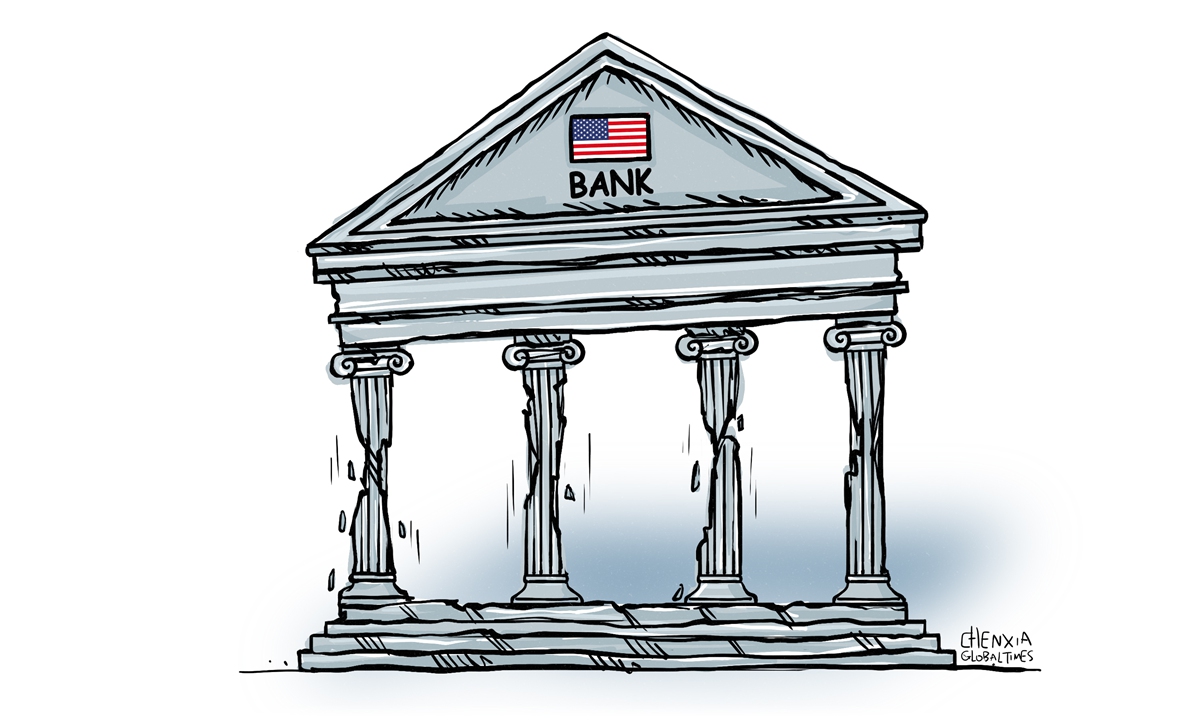
Illustration: Chen Xia/Global Times
The turmoil in the US banking system is hardly over, as the country's 14th-largest private lender, First Republic Bank, capsized and was sold to JPMorgan Chase on Monday.
The meltdown of three banks in succession over the span of two months since early March, including Silicon Valley Bank, Signature Bank and First Republic Bank, doesn't bode well for the viability of the US' financial system.
The number of failing lenders in the US may snowball as about 190 regional banks are seeing their uninsured depositors continue to withdraw savings. If the classic run on the lenders goes on unabated, the overall US financial system could run into bigger trouble, which may send shockwaves across global markets.
If the US Federal Reserve maintains its course of reining in inflation by raising the federal funds rates further this year, more mid-size US banks could go under water and be forced to declare insolvency, because American depositors will withdraw their savings from the regional banks in order to get higher rates elsewhere. This will put a lot more stress on those banks.
First Republic Bank collapsed despite having received a massive $30 billion lifeline from 11 of the largest American banks in March, an emergency measure orchestrated by the US government.
Why did the rescue still fail? The depositors seem to have lost confidence in the US federal policymakers' ability to manage rates as well as bank risks, and they have fled en masse from regional banks after the foundering of Silicon Valley Bank, the largest US bank failure since the 2008 financial crisis.
The contagion has not stopped yet. Similar to the failed trio, other regional banks, whose assets have been battered by the rise in interest rates, will have to fight for their own survival in the coming weeks. Many of the forces behind the trio's cave-in will continue to weigh on the increasing fragile banking system in the US: Elevated inflation, high interest rates, jitters among uninsured depositors and social media chatter that intensifies panic withdrawal of savings from the smaller woeful regional banks.
The US banking system will most likely teeter on this festering crisis so long its regional banks face non-stop runs on deposits. The share prices of many mid-size lenders have fallen significantly, indicating investors' concern that these banks could become the next to First Republic.
In a nutshell, the ongoing American banking system debacle is a predictable consequence of the US central bank keeping interest rates too low for too long after President Joe Biden's $1.9 trillion fiscal splurge as part of the American Rescue Plan, which effectively caused US inflation to surge to four-decade high levels in 2022.
Both the Biden administration and the Federal Reserve made a blunder by insisting that inflation was only "transitory" last year. It turned out the price hikes are not temporary and become deeply trenched in all the goods and services provided in America. By the time that the Federal Reserve officials realized the inflation was sticky and becoming increasingly worse, they scrambled to ramp up interest rates too rapidly over a condensed period. That steep rise in rates, from 0-0.25 percent to currently 4.75-5 percent in merely 12 months, has dumbfounded many economists in the world, severely stressing the US lenders with steadily rising losses.
This is what is causing the runs on American banks. And, the voluminous deposit withdrawals have forced the banks to sell their bonds and other assets in a "fire sale," putting themselves at risk of insolvency. Will the woes at the US banks, plus the downfall of Credit Suisse in Switzerland, continue to worsen and spread to the wider financial sector and lead to a 2008-style financial fiasco, many are holding their breath.
As First Republic Bank capsized, the public were already racing to figure out which other banks might be susceptible to similar woes.
All the more, the US economy, facing stubborn inflation, an ongoing policy tightening and now the banking system tumult, is almost certain to slip into a sizable slowdown, if not recession. Data collected by the Federal Reserve showed last week that commercial and industrial lending and housing sector lending both dropped in March, as lending becomes more difficult and expensive. Commercial real estate loan borrowers rely heavily on mid-size regional banks, which have been battered by the volatility. At the same time, as the credit crunch and economic distress combine, who knows what the endgame will be?
The author is an editor with the Global Times. bizopinion@globaltimes.com.cn




